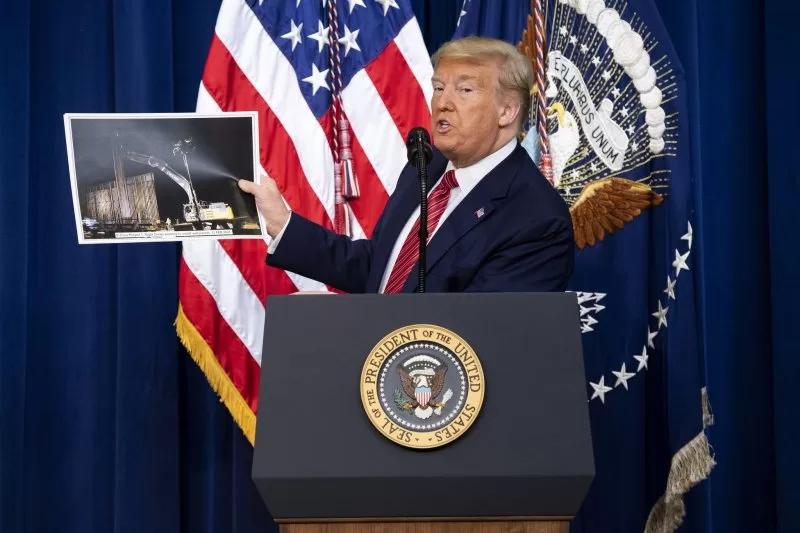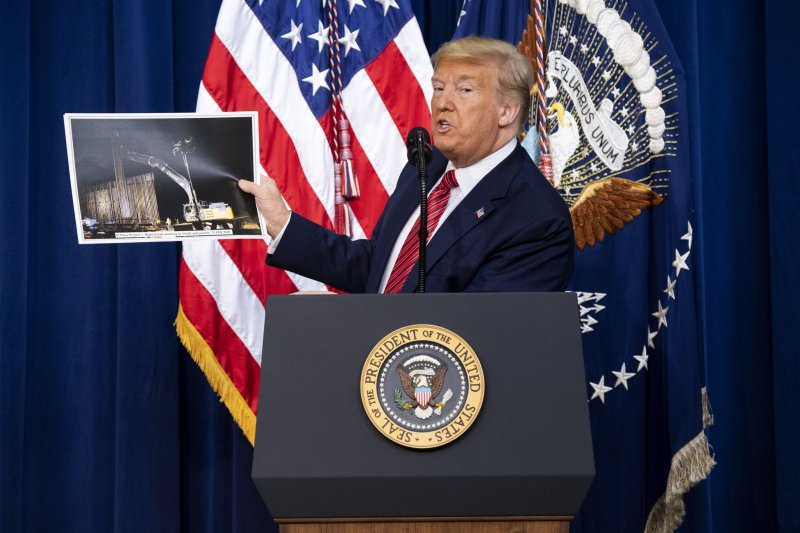1 of 6 | Former President Donald Trump holds up a photo of the border wall as he speaks to the National Border Patrol Council at the White House on February 14, 2020. File Photo by Kevin Dietsch/UPI |
License PhotoFeb. 9 (UPI) — A focus of former President Donald Trump‘s re-election campaign is the familiar promise of more restrictive immigration policies and the construction of a southern border wall. But during his first administration, many of those plans didn’t hold up.
During his 2016 campaign, Trump said in interviews and at campaign rallies that he would suspend immigration from countries “compromised by terrorism,” build a wall along the southern border and make Mexico pay for it, end “catch and release” policies and increase the number of immigration and deportation enforcement agents.
Once he entered the White House, about 500 miles of border wall was built; Mexico did not pay for it. He waffled on creating a path to citizenship. His “remain in Mexico” policy withstood court challenges, but his travel ban did not.
Trump’s rhetoric cast migrants crossing the southern border, including refugees fleeing violence, as a threat to the United States. He said immigrants from Mexico were “rapists” and bringing drugs and crime to the United States, stoking a level of fear that was uncommon in past elections.
But Colleen Putzel-Kavanaugh, an associate policy analyst for the Migration Policy Institute, told UPI that Trump’s campaign rhetoric seized on a narrative of fear that already existed.
“Trump coming in, really there was an opening created for people who were really against things like DACA or other changes that reinforced our immigration system,” she said, referring to the Deferred Action for Childhood Arrivals Act. “The rhetoric is really important.”
Trump’s current rhetoric from the campaign trail is fueling congressional debate over a bipartisan bill to provide $20.23 billion for Southwest border enhancements and expand the authority of the president. The bill has failed to pass the House of Representatives.
President Joe Biden and other Democrats pin the failure on Trump’s opposition to the bill, alleging easing the border crisis would hurt Trump politically.
Southern border
One of Trump’s marquee campaign proposals in 2016 was the construction of a southern border wall. On Oct. 22, 2016, Trump said he would pass a law to fund the wall with an agreement that Mexico would reimburse the United States for the costs of construction.
Five days after being inaugurated in January 2017, Trump issued a pair of executive orders, including the Border Security and Immigration Enforcement Improvements order, calling for construction of the wall.
About 500 miles of border wall was built. The border with Mexico is about 2,000 miles long. Mexico did not pay for any of the construction.
In the fall of 2016, weeks before the election, Trump said he would see to it that the long-gestating biometric entry-exit visa tracking system would be completed under his presidency.
Trump ordered that the system’s completion be expedited as part of his March 6, 2017, executive order: Protecting the Nation From Foreign Terrorist Entry.
Congress first called for development of the system with the Illegal Immigration Reform and Immigrant Responsibility Act of 1996. The biometric entry system, an automated system that recognizes a person’s unique characteristics like fingerprints, was fully implemented by the Department of Human Services in 2006.
The exit system has not yet been implemented.
Trump vowed to triple the number of ICE deportation officers and hire 5,000 additional Border Patrol agents. He requested funding to hire an additional 1,000 or more border agents as part of his annual budget, but Putzel-Kavanaugh said it is difficult to verify whether those positions were filled.
“Even if Congress allocates the money it doesn’t mean all those people were hired,” she said. “It depends on the hiring pool.”
Trump’s first executive orders included the authorization to permit state and local law enforcement agents to act as immigration agents and detain immigrants at the direction of the Department of Homeland Security.
‘Wider net’ for deportation
Along with the promise to build a wall, Trump forecast a more aggressive effort to deport immigrants who did not receive authorization to live or work in the United States.
His earliest campaign comments cast his stance as having little tolerance for residency in the United States without proper documentation. He would walk this back some, noting in September 2016 that he would consider allowing undocumented immigrants that serve in the U.S. military to stay.
Trump also went on to comment that he recognized the challenge to removing immigrants who have lived in the United States and established themselves for years. He would go back and forth on this sentiment, saying once in August 2016 that he was open to creating a path to citizenship for people who are in the United States but do not have criminal records.
By the end of the month, Trump reversed course again, saying the only path to citizenship is to apply, then return to their home country to await a decision.
In January 2019, the Migrant Protection Protocols were enacted. These protocols authorized the government to return migrants from Mexico to their home country. It ordered that they wait in Mexico until their scheduled court appearance.
The protocols excluded unaccompanied children.
The former president followed this policy with Asylum Eligibility and Procedural Modifications, which made immigrants who entered or attempted to enter the United States without applying for authorization ineligible for asylum.
Trump did expand on the authorization to remove undocumented immigrants, as well as narrowing who would be eligible for citizenship or asylum in the United States.
“There were changes to interior enforcement that made a wider net for people to be deported by ICE,” Putzel-Kavanaugh told UPI of Immigration and Customs Enforcement. “But it was actually fewer people deported than Obama because ICE resources were redirected to the southern border.”
In President Barack Obama‘s last term, nearly 1.5 million noncitizens were removed from the United States, according to a report by the Office of Homeland Security Statistics. Nearly 1.2 million were removed under the Trump administration between fiscal years 2017 and 2020, though the COVID-19 pandemic played a role in slowing immigration-related activities.
Travel ban
Trump’s first two executive orders called for the broad removal of “ineligible immigrants,” called for individuals suspected of violating immigration law to be detained and reinstituted the Secure Communities program that outlines the priorities for removing undocumented immigrants.
In the summer of 2016, Trump said he would immediately suspend immigration from countries “compromised by terrorism.” On Jan. 27, 2017, Trump signed another executive order: Protecting the Nation from Foreign Terrorist Entry Into the United States.
The order called for the suspension of the U.S. Refugee Admissions Program for 120 days. It also would institute an indefinite suspension of entry by Syrian refugees and a 90-day ban on immigration from Iran, Libya, Somalia, Sudan, Syria and Yemen.
In September 2017, the ban was expanded to include Chad. Sudan was once included but later removed.
The executive order faced many legal challenges and was quickly shelved through multiple iterations. Critics referred to it as a “Muslim ban,” because it focused on countries that predominantly practice Islam.
During fiscal year 2017 — starting October 2016 — 53,691 refugees arrived in the United States. It was the fewest arrivals since 2007. The country of origin for the largest portion of refugees was Afghanistan with 1,311.
President Joe Biden revoked the travel ban on his first day in office in 2021.
Family separations
By 2019, reports of inhumane living conditions at Border Patrol encampments and children being separated from their families were numerous.
The Department of Health and Human Services identified 2,737 cases of children who were separated from their parents as of January 2019. In its report, it noted that thousands more may have also been separated.
The reported number rose to more than 3,000.
The Office of Inspector General later reported that Trump’s attorney general, Jeff Sessions, drove a zero-tolerance policy at the border, using it as a deterrent.
“We need to take away children; if care about kids, don’t bring them in; won’t give amnesty to people with kids,” Sessions told U.S. attorneys, according to the report.
In June 2018, Trump signed the executive order: Affording Congress an Opportunity to Address Family Separation, directing for immigration proceedings involving families to be prioritized.
“It is unfortunate that Congress’ failure to act and court orders have put the administration in the position of separating alien families to effectively enforce the law,” the executive order reads.
Impact of policy
As Trump again fashions himself as the “strong border” candidate, immigration data tell a cloudier story.
In Trump’s first fiscal year in office, more people obtained lawful residence in the United States than seven of the eight fiscal years of the Obama presidency. There were fewer apprehensions at the border, returns or removals than any year since 1971.
Enforcement data is not the only indicator of “strong” or effective policy, Putzel-Kavanaugh said. In fact, the definition of a “strong border” is likely to differ from person to person, she said.
“If you look at enforcement funding over the last decade or more, it has increased steadily every single year,” she said. “Those resources are going toward funding more Border Patrol agents, increasing detection technology, even paving roads along the southern border so Border Patrol can drive them more easily.”
Putzel-Kavanaugh added that more often migrants are waiting to be apprehended by Border Patrol agents, in search of protections.
“The border has changed over time,” she added. “The challenges in some ways have been similar, but they’ve also fundamentally changed over time. The definition of what a strong border is, that can’t be a static definition.”
According to the Migration Policy Institute’s report on the Trump administration’s border policies, 17% fewer immigrants submitted applications for permanent residence in fiscal year 2019 than 2016. There were 22% fewer in 2020 than 2016.
The number of charging documents — documents that enter immigrants into removal procedures — rose by 52% from 2016 to 2019.
“The stream of different initiatives at the border, many of those were also mired up in litigation. That doesn’t say in the time they were in place they didn’t have different effects,” Putzel-Kavanaugh said. “There were lower arrivals but also harsh effects on the migrants themselves.”

